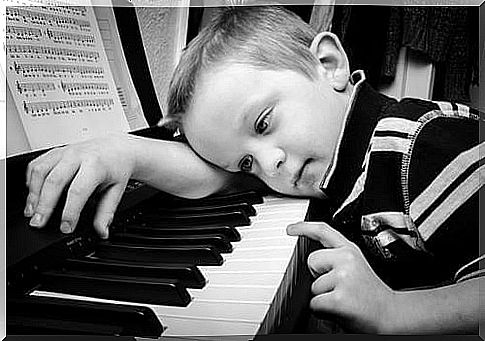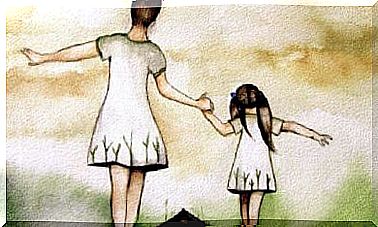What Hides Behind A Discouraged Child

The discouraged child who does not do his homework, who responds apathetically or disinterestedly to our demands, is not always well understood. Although it is easier to resort to reproach for their behavior, we must keep in mind a simple aspect. Behind the discouragement there may be neglected realities, adverse emotions, and underlying problems that need to be detected.
Let’s face it, one way or another, many discouraged children and adolescents end up becoming discouraged adults as well. If we get used to living with this constant frustration early and our environment also limits itself to responding to us with criticism and threats, we end up chronifying that feeling of failure. Self-esteem is undermined early and almost irretrievably.
Discouragement is just a mask, an attitude to the world that hides something else. It is the relief of an internal anatomy that it is necessary to glimpse as soon as possible. Because there is nothing more dangerous and devastating than discouragement, than that lack of motivation capable of relegating the child to the corner of disinterest, constant anger and that behavior that is almost always the object of sanction and not of understanding.

The discouraged child, what explains this attitude?
If there is something that we all like, it is to see a curious child, who is related to his environment, who asks, who plays, who does not stop moving, touching and experimenting. Childhood is movement and energy, it is the desire to understand and position yourself in a reality where you feel acceptance and affection at all times.
Perhaps, for this reason, we are so struck by seeing a discouraged child that, lying on his desk or on the bed in his room, he opts not only for stillness, but for that defiant refusal to carry out any task. Faced with these recurring situations, we must understand a first aspect. As explained in an article published in the Journal of Educational Psychology , by Adele Gottfried, motivation is driven by emotion.
If a child, adolescent or any adult shows discouragement, it is most likely that there is a whole complex underlying emotional reality underneath that situation. Therefore, if we limit ourselves to punishing that child for his attitude, what we will be doing with it is to feed back the discomfort even more.

What could be behind the infantile discouragement?
Behind the infantile discouragement there can be infinite realities. Likewise, we must become aware of something important. Children do not always have the resources to explain exactly what happens to them ; we must therefore be close and facilitate an adequate opening. Let’s see, however, what can be behind a discouraged child.
- Learning problems and frustration. We cannot forget that in classrooms we sometimes have a large number of children with undetected special educational needs. Thus, problems such as inattention, intellectual giftedness or dyslexia often lead to discouragement in children.
- Nor can we rule out bullying. There are families who are not aware of the traumatic daily life of many children in schools. Let us therefore not rule out this possibility.
- Constant frustration is another common occurrence. There are children and adolescents who go from ‘I can’t do it to I don’t want to do it’ in a matter of no time. Teaching them early to tolerate and handle frustration, anxiety and the feeling of failure will allow them to mature in this regard.
- Nor can we forget an important detail. Many children feel stressed. And not only that, they demand the attention of parents. Offering them time to play, to share moments with the family where they feel cared for, listened to and validated, will inject them with an adequate dose of positive emotions that are ideal to regain motivation.
How to treat child and youth discouragement?
The discouraged child needs no more reproaches or sanctions for his behavior. It needs our attention. Let’s try, for a moment, to put ourselves in their shoes and remember what it feels like when discouragement and apathy embrace us. It is not a pleasant sensation and, although it is true that as adults, experience reminds us what we can do in these situations, children have neither the resources nor our experience to know how to react.
Therefore, it is necessary that we take into account the following strategies:
- Be empathetic. The closeness that he welcomes without judging is the best mechanism for the child to be able to tell us about his emotions, what he feels and what happens to him.
- Positive dialogue. Using emotionally positive communication will also facilitate a connection with the little one. We must also try to focus on fostering their motivation, on reminding them of the good things about themselves, their potential and possibilities. Create an emotionally safe haven for the child to feel comfortable communicating and seeing new perspectives on their problems.
- Reboot. Sometimes, to regain lost motivation it is necessary to start from scratch. Something as simple as changing routines and offering new stimuli, challenges and proposals, can make the child put aside frustration or negativity when finding new interests. Finding something they like (a sport, music, any hobby …) can act as a trigger and also as a new strategy to connect with children through an activity.

To conclude, the discouraged child does not need reproaches, he demands attention. Let’s not leave that dull look, that inappropriate behavior, that misplaced word or that ‘I can’t’ until tomorrow . Motivation gives impulse to life, so we cannot allow children to lose an iota of the force that this engine generates in their lives.









